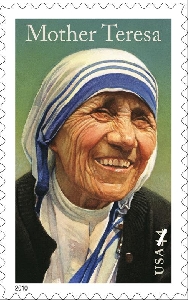2010 Stamp Program Unveiled -- U.S. Postal Service Recognizes Mother Teresa

WASHINGTON, Jan 2 /
Christian Newswire/ -- Nobel Peace Prize honoree Mother Teresa, legendary actress Katharine Hepburn, Negro Leagues Baseball and Cowboys of the Silver Screen are among the subjects headlining the 2010 stamp program, the U.S. Postal Service announced on Dec. 30, 2009.
In addition, consumers get much-needed assistance in sending greeting cards: the first stamp designed especially for oversized or odd-sized cards. On May 17, the Postal Service will issue the Monarch stamp for use on cards that require additional postage. An illustration of a generic butterfly will be depicted on cards or envelopes to remind customers to buy the new Monarch butterfly stamp.
Mother Teresa
With this stamp, the U.S. Postal Service recognizes Mother Teresa, who received the Nobel Peace Prize in 1979 for her humanitarian work. Noted for her compassion toward the poor and suffering, Mother Teresa, a diminutive Roman Catholic nun and honorary U.S. citizen, served the sick and destitute of India and the world for nearly 50 years. Her humility and compassion, as well as her respect for the innate worth and dignity of humankind, inspired people of all ages and backgrounds to work on behalf of the world's poorest populations.
Mother Teresa, an ethnic Albanian, was born Agnes Gonxha Bojaxhiu on Aug. 26, 1910, in Skopje in what is now the Republic of Macedonia. Drawn to the religious life as a young girl, she left her home at the age of 18 to serve as a Roman Catholic missionary in India. "By then I realized my vocation was towards the poor," she later said. "From then on, I have never had the least doubt of my decision." Having adopted the name of Sister Mary Teresa, she arrived in India in 1929 and underwent initial training in religious life at a convent in Darjeeling, north of Calcutta. Two years later, she took temporary vows as a nun before transferring to a convent in Calcutta. She became known as Mother Teresa in 1937, when she took her final vows.
Following a divine inspiration and deeply moved by the poverty and suffering she saw in the streets of Calcutta, Mother Teresa left her teaching post at the convent in 1948 to devote herself completely to the city's indigent residents. Two years later, she founded her own congregation, the Missionaries of Charity. Like Mother Teresa, the nuns of the new order wore white saris with a blue border rather than traditional nuns' habits. In addition to the traditional vows of chastity, obedience, and poverty, they took a fourth vow of wholehearted free service to the poorest of the poor. "In order to understand and help those who have nothing," Mother Teresa told the young women, "we must live like them."
When Mother Teresa accepted the 1979 Nobel Peace Prize--one of her numerous honors and distinctions--she did so "in the name of the poor, the hungry, the sick and the lonely," and convinced the organizers to donate to the needy the money normally used to fund the awards banquet. Well respected worldwide, she successfully urged many of the world's business and political leaders to give their time and resources to help those in need. President Ronald Reagan presented Mother Teresa with the Presidential Medal of Freedom in 1985, the same year she began work on behalf of AIDS sufferers in the U.S. and other countries. In 1997, Congress awarded Mother Teresa the Congressional Gold Medal for her "outstanding and enduring contributions through humanitarian and charitable activities."
Mother Teresa died in Calcutta on September 5, 1997, and is buried there. She had been a citizen of India since 1948.
In 1996, President Bill Clinton and the U.S. Congress awarded Mother Teresa honorary U.S. citizenship. As of February 2009, the honor has only been bestowed on five others. Winston Churchill received it in 1963, Raoul Wallenberg in 1981, William Penn and Hannah Callowhill Penn in 1984, and the Marquis de Lafayette in 2002. With the exception of Hannah Callowhill Penn, each of these figures has also appeared on a U.S. postage stamp: the Marquis de Lafayette four times (1952, 1957, 1976, and 1977), William Penn in 1932, Churchill in 1965, and Wallenberg in 1997.
The stamp features a portrait of Mother Teresa painted by award-winning artist Thomas Blackshear II of Colorado Springs, CO.
The Postal Service receives no tax dollars for operating expenses, and relies on the sale of postage, products and services to fund its operations.
For more information and low-resolution images on the stamps in the 2010 series, visit USPS Newsroom at usps.com/news.

